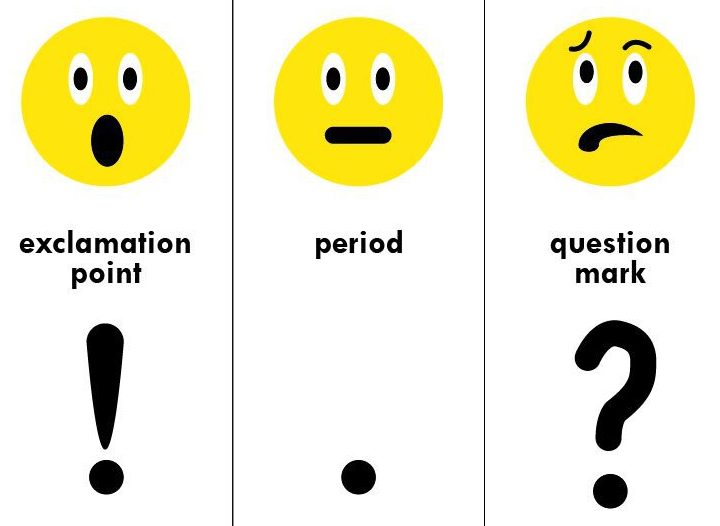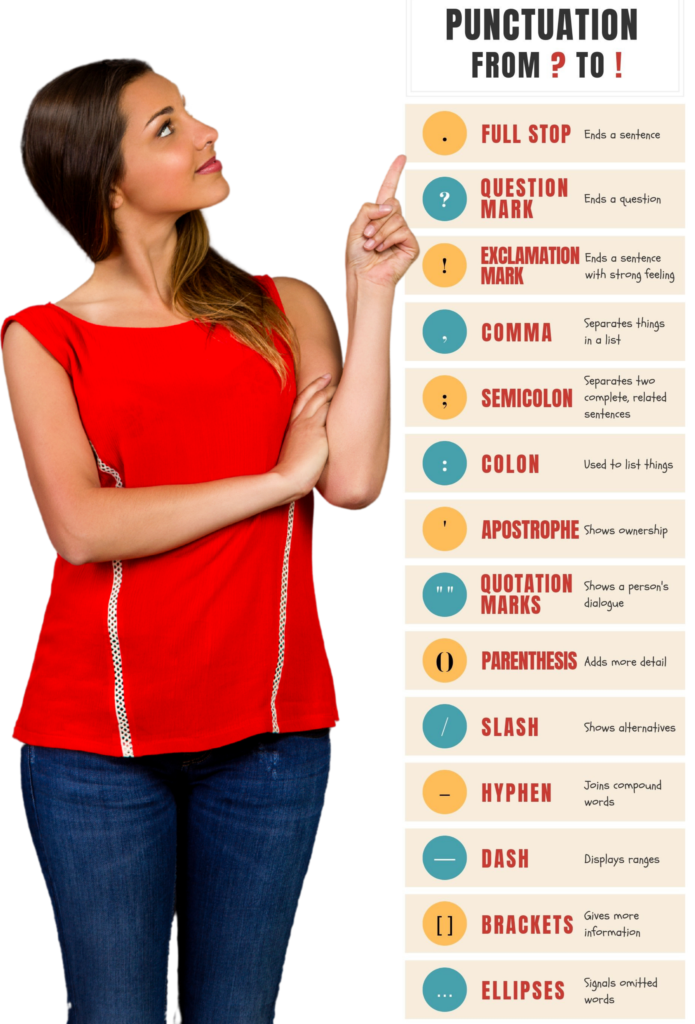What is Punctuation?
Punctuation is a collection of tools used in writing to differentiate between sentences, phrases, and subjects so that their true meaning can be comprehended. Punctuation is a set of symbols that we use to clearly explain the meaning of our sentences and to keep the text flowing smoothly. It directs us when we should stop, divides concepts, indicates when a phrase is quoting someone else’s words and performs a number of other duties.

Each symbol is referred to as a “punctuation mark.” Punctuation is used to create the pattern and meaning of the written text. Many pieces of writing would be open to many interpretations if punctuation was not used.
Which sentence is punctuated correctly?
We must identify the right punctuated statement in the given question. Punctuation marks are symbols that are used in writing to divide sentences and their components, as well as to clarify meaning. Full stops, commas, and brackets are among them.
- Constantly ask yourself a question like: Am I satisfied with the results?
- You should always ask yourself: Am I satisfied with the results?
- One thing you should always ask yourself is: Am I happy with the outcome?
- Always ask yourself, Am I satisfied with the results?
The first statement is incorrect because it uses the word “like,” which is typically used for comparison. It isn’t appropriate because you aren’t comparing two questions. Because the colon is appropriately utilized and the question mark is used at the conclusion of the phrase, the second question is correct. The word “is” appears before the colon in the third sentence, implying that it is a declaration rather than a list. As a result, it would be inappropriate. The fourth and last sentences use a comma instead of a colon, so they are punctuated incorrectly.
What is a Punctuation Mark?
Punctuation is a very useful tool. It breathes life into the written content and helps in conveying the authors’ meanings and purposes. There are fourteen main punctuation marks in the English language, and here is a list of them. The full stop and quote marks are two punctuation marks that have multiple names among English speakers.

- A full stop or a period (.)
- The comma (,)
- The Question mark (?)
- The exclamation mark (!)
- Quotation marks (” “)
- An apostrophe (‘)
- Dash (– or —)
- Hyphenation (-)
- Colon (:)
- Semicolon (;)
- Parentheses ()
- Brackets []
- Ellipsis (…)
- Slash (/)
A PERIOD or a FULL STOP (.)
This is the most widely used punctuation mark because it is impossible to write a single phrase without it. A full stop is typically used to denote the end of a statement or to follow an abbreviation.
For example:
- We have to feed this cat every evening.
- David isn’t happy with the new restrictions.
- September = Sept.
- Pages = pp.
- Telephone Number = Tel. No.
THE COMMA (,)
In a statement, a comma is frequently used to separate different concepts. It does have a variety of different applications, all of which should be remembered.
For example:
- Mark took the bus, and Allison took the train.
- We went to the fruit market and bought apples, peaches, grapes, and oranges.
QUESTION MARK (?)
Simply said, a question mark signifies that a sentence is asking a question. It’s always the last word in a sentence:
For example:
- What is your age?
- Do you recall what I said to you the other day?
EXCLAMATION MARK (!)
The use of an exclamation mark at the end of a sentence emphasizes the importance of the sentence. It can signify sadness, happiness, enthusiasm, or any other strong emotion, depending on the content of the statement.
For example:
- Don’t bother me!
- I’m really excited to see Paris!
QUOTATION MARKS (“ ”)
When quoting someone else’s speech, quotation or speech marks are used to separate it from the rest of the speech. They can also be used for titles of articles, book chapters, TV programs, and so on.
For example:
- “I love sweets,” said Joy.
- “Don’t do that, George!”
APOSTROPHE (‘)
The apostrophe, often known as an inverted comma means ownership or possession. There are two very essential uses for an apostrophe. It can be substituted for deleted letters in contractions. Second, it can be used to demonstrate ownership.
For example:
- The male wore a blue hat, for example (male is in the singular).
- The male wore blue hats (male in this instance are plural).
DASH (– or —)
The en dash and the em dash are two separate dashes, with the one being somewhat shorter than the second. The en dash is commonly used to indicate a link between two items, as well as a range of numbers, years, pages, and so on.
For example:
- I need to study pages 45–78 of the textbook for tomorrow’s session.
- Second-class mail
- Gender-specific
A comma, colon, or parenthesis can all be replaced with an em dash. It can also be used to emphasize the ending of a sentence.
HYPHENATION (-)
A hyphen, despite its resemblance to a dash, has quite different functions. The most typical application is to make compound words.
For example:
- He is a self-confident individual.
- part-time
- sub-part
COLONIAL (:)
Within a sentence, a colon creates a clear gap between two phrases. It can be used to introduce a quote, a list, an explanation, or an example. You can also use it to draw attention to a particular point.
For example:
- She loaded the trolley with the following items: snacks, veggies, and meat.
- Human Resource Management: Plans for employees
SEMICOLON (;)
The semi-colon is one of the most difficult punctuation marks to learn. It can be used to establish a break between two distinct clauses that are still interconnected.
For example:
- My brother is a doctor; my sister is a writer.
PARENTHESES ()
In most cases, more information will be found in parenthesis. It can usually be omitted without causing the reader any confusion.
For example:
- My girls (ages 6 and 8) adore playing with our neighbors’ dogs, for example.
BRACKETS []
Brackets are comparable to parentheses in certain ways. They are, however, largely used in academic writing and to show quotes. Without modifying the original quotation, the writer can provide more information or correct errors in brackets.
For example:
- She love[s] cooking.
- Lucy said, “I love David [his younger brother]”.
ELLIPSIS (…)
In the text, an ellipsis creates a fascinating and mysterious mood. It can also be used to demonstrate that some letters or even entire words have been absent.
For example:
- So…. what happened after that?
- She was intelligent, humorous, and attractive, but… something didn’t feel right.
SLASH (/)
Many individuals substitute the slash for or, and so on. In your text, you may need to include a fraction, a measurement, or other suggestions. These are only three examples of when you’ll need to utilize a slash.
For example:
- You’ll need 1/2 cup of baking powder for this recipe.
- The automobile was traveling at speeds of up to 110 km/h.
- The On/Off button must be pressed.
How to Punctuate Book Titles?
These are the nine basic punctuation rules for book titles.
- The first and last words of the title should always be capitalized.
- Capitalize keywords such as proper nouns, verbs, nouns, and adjectives.
- Subordinate conjunctions like as, as, or because should always be capitalized.
- After a colon, always capitalize a word.
- Articles, a, an, and the should never be capitalized unless they are the initial word in the title.
- Avoid using coordinating conjunctions like but, and, or, if, or nor.
- Short prepositions with less than five letters, such as at, to, from, in, should never be capitalized.
- Use a phrasal verb particle-like give out, walk away, push on, give in, or get over to capitalize on a phrasal verb particle.
- There are no commas or full stops, but hyphens and question marks are frequently utilized.
If you’re mentioning a book, the punctuation rules for book titles listed above are fine, and it’s unlikely that you’ll make a mistake. You may look up how to punctuate book titles in a variety of places. The Chicago Manual of Style, the APA Style Guide, the MLA Handbook, The Oxford Style Guide, and many others are useful resources. The English language styles of Americans, British, Australians, and Canadians may differ slightly. However, the essential rules for punctuating book titles are the same in all dialects of English.
Why is it important for students to learn What is Punctuation?
It is frequently stated that you only get one chance to make a good first impression. Punctuation is vital for students’ effectiveness in everyday writing practice, tests, and other academic assignments. We’ve all had students in our classes whose homework might be fantastic if only it was punctuated correctly. Understanding how punctuation can modify the tone of sentences is essential for students to improve their writing skills.
- Using punctuation in your writing improves the reader’s comprehension of the content.
- Punctuation errors can totally change the meaning of a phrase.
- Punctuation is used to indicate pauses and to draw attention to specific topics or ideas in the content.
- Punctuation accuracy is very important in academic writing because it serves to enhance arguments presented in the text.
Expert Writers Help
It is important to utilize accurate punctuation in all of your writing. Even the smallest mistake can have a significant impact on academic performance and credibility. Our expert writers can help you punctuate your university paper. There are several Punctuation Checkers available online, but students must choose expert guidance. Use our assignment help services to get flawless content if you actually want to earn top grades on your paper.




